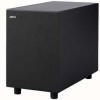Jamo SUB 200 Catalog - Page 40
Jamo Tech platforms
 |
View all Jamo SUB 200 manuals
Add to My Manuals
Save this manual to your list of manuals |
Page 40 highlights
WAVEGUIDE WaveGuide is the unique way Jamo has shaped the tweeter's faceplate. The result is a controlled sound pattern with a more open and dynamic reproduction of sound. WaveGuide makes it easier to position the speakers in the room. Another big challenge is to secure a uniform dispersion pattern in the treble and midrange frequencies. In general, the dispersion is getting narrower as the frequencies get higher. Consequently in the area where the mid/woofer and the tweeter should integrate smoothly, the mid/woofer has a narrow dispersion and the tweeter has a wide dispersion. This problem is solved with the Jamo WaveGuide. The completely smooth design of the WaveGuide also reduces diffractions to an absolute minimum. Finally, the WaveGuide increases treble output in the lower treble range, which means the tweeter needs less power for the same SPL. So, power handling is improved and distortion is reduced. HCC (HARD CONICAL CONE) The HCC technology (Hard Conical Cone) enables the driver to reach far beyond midrange frequencies before any significant cone break-ups occur. The material's rigidity and the cone's conical shape ensures the unit creates clear and detailed sound with very little distortion, even at high sound pressures. This combines with the natural rubber suspension, which effectively prevents vibrations from travelling back to the diaphragm; the result is a very well-controlled diaphragm that operates vwithout break-ups up to 4kHz -well beyond its working range. Jamo HCC operates without break-ups. Signal well attenuated after 1msec. dB 25.0 20.0 15.0 10.0 5.0 1k 2k Cumulative Spectral Decay Hz dB (SPL) 120 110 100 ▲ On-axis 90 ▼ Off-axis 80 70 60 50 40 30 20 100 WaveGuide 200 Normal tweeter 500 1k 2k 5k 10k 20k The WaveGuide result in a uniform treble dispersion pattern from 10kHz all the way down to the critical x-over point at 2kHz and thus secures a seamless transition to the mid/woofer - both when listening on and off axis. Other speaker break-up. Signal still occuring after 1msec. dB 25.0 20.0 15.0 10.0 5.0 1k 2k Cumulative Spectral Decay Hz 0.00 0.50 1.00 1.50 2.00 2.50 4k msec 4k 0.00 0.50 1.00 1.50 2.00 2.50 msec 4k msec 4k Jamo Tech platforms CENTRE-PLUG The Centre-Plug replaces the traditional dust cap, making the cone both lighter and more responsive, while also cooling the voice-coil resulting in higher power handling and a stable sound reproduction when playing loud. The design produces increased power-handling capabilities along with a more uniform, precise and dynamic reproduction of sound. The Centre-Plug also prevents potential break-up points where the dust cap would have been glued to the cone. In addition, it prevents over- and under-pressure behind the dust cap when the cone moves back and forth. The advantage is more dynamic and precise sound reproduction. DTT (DECOUPLED TWEETER TECHNOLOGY) DTT (Decoupled Tweeter Technology) is a mounting system specially developed by Jamo. One of the biggest challenges when designing speakers is preventing unwanted cabinet vibrations from clouding or colouring the sound. High frequencies are particularly susceptible. This problem is solved using the ingenious Jamo DTT. By decoupling the tweeter from the rest of the loudspeaker, vibrations transmitted from the front baffle to the tweeter are reduced by more than 20dB, resulting in an uncommonly detailed and realistic reproduction of high frequencies. dB (SPL) 100 95 90 85 80 75 Centre-Plug Normal speaker unit 70 50 100 200 500 1k 2k 5k Sound pressure level from a speaker with Centre-Plug compared to one without. dB 125 120 115 110 105 100 95 90 85 80 75 70 Normal front baffle DTT Overplot 60.0 100.0 1000.0 Difference between vibrations in a normal front baffle and vibrations in a front baffle employing Decoupled Tweeter technology. 78 79















